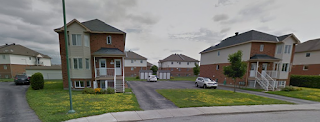 |
| imperial overreach: La Nouvelle France (Atlantic Ocean named Canadian Ocean) |
Sept 26 – In several ways, Montebello reflects much of the history of Quebec. European
land rights in this region of New France were first granted in 1627 by the King
of France. This seems utterly absurd
from our perspective today, since the area was already inhabited by Algonquins
and neither the French king nor his lords had any relationship to this land. But in Europe monarchs ruled by claiming a divine
right from God, and French missionaries had already established relations with
some tribes of First Peoples and claimed to have converted them to Catholicism.
 |
| typical land grant layout |
In 1627, Cardinal
Richelieu, King Louis XIII's chief minister, granted the newly-formed Company of
New France all lands between the Arctic Circle to the north, Florida to the
south, Lake Superior in the west, and the Atlantic Ocean in the east. In exchange for this vast land grant and the
exclusive trading rights tied to it, the Company was expected to bring two to
three hundred settlers to New France in 1628, and a subsequent four thousand
during the next fifteen years. To achieve this, the Company sub-granted almost
all of the land awarded to it. The “seigneurial”
land grant system of New France was the semi-feudal system of land tenure used
in the North American French colonial empire. Seigneurs (“Lords”) were allotted land
holdings and presided over the French colonial agricultural system in North
America.
 |
| Papineau family chapel |
In 1674, François
de Laval, the first Archbishop of Quebec, purchased vast property around
Montebello, known as the Seigneury de la Petite Nation, from the French East
India Company. The Quebec Seminary
inherited it from Laval. Agricultural settlement of this area began in 1801, when the land of the Petite Nation
Seigneury was purchased by Joseph Papineau, a former anti-British rebel in Lower
Canada, who operated a lumber mill at this site. Papineau’s
son, Louis-Joseph, inherited this Seigneury property and gave the name
"Monte-Bello" to this location in 1854 as a tribute to
Napoleon-Auguste Lannes, Duke of Montebello, a French diplomat and foreign
minister, with whom he had become acquainted in France.
 |
| Manoir Papineau |
Starting in
1846, Louis-Joseph built a turreted stone mansion in beautiful French style, named
Manoir Papineau. After the seigneury
feudal system was abolished, the Papineau seigneury was sold off and became the
Seigneury Club. The grand house was later
designated a National Historic Site of Canada, and now functions as a museum
which is open in the summer.
 |
| Château Montebello |
This village
of about 1,000 people is also famous for the Château Montebello resort, the
largest log structure ever built. In the late 1920s, Harold M. Saddlemire, a
Swiss-American entrepreneur, acquired the site that was formerly part of the Seigneury
de la Petite Nation, situated on one of the last surviving land grants made by
17th-century French kings to early settlers of what was then La Nouvelle
France. Saddlemire envisioned a private
wilderness retreat for business and political leaders. He initially called this project
"Lucerne-in-Quebec;" but it came to be known as the Anglicized “Seigniory
Club”.
 |
| impressive stone fireplace in hotel lobby |
Despite the 1929 stock market
crash, work on the planned wilderness retreat began as planned in early
1930. The economic uncertainty did not
delay the project, as it did so many others, due perhaps to the fact that the
presidents of the Canadian Pacific Railway, the National Bank of Canada, the
Bank of Montreal, and the Royal Bank of Canada, and the Premier of Quebec, were
all club directors. A special spur from
the nearby CPR line had to be built to allow for the transport of red cedar
logs and other supplies to the site. The log construction in a Scandinavian style
was supervised by Finnish master-builder, Victor Nymark and construction
manager Harold Landry Furst.
 |
| Le restaurant Aux Chantignoles |
The club was
only open to an elite membership for its first 40 years of operation. Among the members during this period were:
former Canadian Prime Minister Lester B. Pearson, Queen Juliana of the
Netherlands, Prince Rainier and Princess Grace of Monaco. Edward, the playboy Prince of Wales, heir to
the British throne, visited the resort.
After he became King Edward VIII, then abdicated his throne to marry
Wallis Simpson and become the Duke of Windsor, he visited the Seigneury Club again.
The resort has been the host for the
NATO Nuclear Planning Group, a G7 Economic Summit, and a Trilateral summit
conference (Mexico, US, Canada).
 |
| luxury dining with a winter view |
Château Montebello is a National
Historic Site of Canada, set within a forested wildlife sanctuary with numerous
lakes, but it now operates as a private hotel.
Its ownership has passed through the hands of the Canadian Pacific
Railway, a Saudi prince, an employee retirement system, and a major Chinese
real estate group.
Footpaths are
laid out through the surrounding wildlife sanctuary, and to my amazement I
discovered that they are accessible via Google Street Views! Since Google has mapped most of North America
using camera-laden cars on public roads, how was this maze of footpaths
filmed? Cameras on bikes? On golf carts? I’m grateful for this enhanced access, but I
wonder why this little bit of strolling territory (complete with “Poison Ivy”
signs!) was given this privilege.
 |
| Amnesia Rockfest |
Since 2005,
Montebello also hosts the Amnesia Rockfest at the edge of the Ottawa River. It has become Canada's largest
rock festival.
 |
| Restaurant Le Napoleon |
The main
street of Montebello, along the edge of the resort property, is full of
boutiques and bed-&-breakfast inns for tourists, built in charming French
architectural styles.
info: Wikipedia.com
Montebello: http://www.montebello.ca/
Château Montebello: http://www.coupsdecoeurpourlemonde.com/2014/07/le-chateau-montebello-canada-bois-rond/
images: Google.com






















